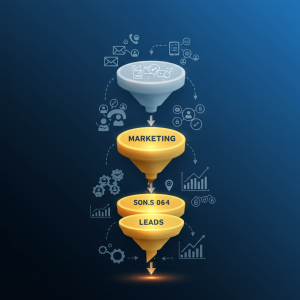What Companies Use Outbound Marketing?

The business world often presents digital marketing and inbound strategies as the only viable paths forward in our interconnected age. Yet beneath the headlines about content marketing and social media success stories lies a surprising truth: outbound marketing continues to drive significant revenue for companies across numerous industries. Far from being obsolete, outbound approaches have evolved alongside digital transformation to remain remarkably effective when implemented strategically.
Tech Giants Still Bet Big on Outbound
Contrary to popular belief, many technology companies—including those selling digital transformation itself—rely heavily on outbound marketing tactics. Salesforce, despite pioneering the SaaS model and producing mountains of inbound content, maintains one of the largest and most aggressive outbound sales operations in the business world. Their multi-channel approach combines targeted email campaigns, phone outreach, and high-touch field sales activities.
Similarly, Oracle continues investing significantly in outbound marketing despite its digital sophistication. The company’s enterprise sales strategy includes extensive trade show presence, direct mail campaigns to C-suite executives, and highly personalized outreach to target accounts. These efforts complement rather than replace their digital marketing initiatives.
Even Google, despite being the ultimate inbound marketing case study, employs outbound tactics for its Google Cloud Platform and Google Ads divisions. Their enterprise sales teams actively pursue named accounts through coordinated outreach campaigns, demonstrating that even digital-native companies recognize outbound’s unique value in certain contexts.
B2B Services Depend on Outbound
Professional services firms across consulting, legal, accounting, and specialized B2B service categories typically rely heavily on outbound marketing approaches. McKinsey & Company, despite publishing influential thought leadership content, still generates significant business through proactive outreach, relationship development, and networking—all classic outbound approaches.
According to research from Bain & Company, high-value B2B services continue to close approximately 62% of enterprise deals through outbound-initiated relationships rather than inbound inquiries. This statistic highlights the enduring importance of proactive selling in complex B2B environments.
Law firms like Baker McKenzie combine sophisticated content marketing with traditional outbound tactics like industry event sponsorship, direct relationship development, and targeted outreach campaigns. Their marketing approach recognizes that waiting for clients to find them proves insufficient in competitive professional services markets.
Manufacturing and Industrial Sectors
Traditional industrial companies continue relying heavily on outbound marketing, often finding greater ROI from these approaches than from digital alternatives. Caterpillar maintains extensive dealer networks supported by coordinated outbound marketing campaigns, event participation, and direct relationship management. Their success demonstrates how established outbound channels remain vital in industries with complex distribution networks.
Similarly, companies like 3M and Siemens leverage trade shows, direct sales teams, and targeted account-based marketing programs to maintain market position. These organizations understand that waiting for prospects to discover them online would sacrifice significant market share to more proactive competitors.
Manufacturing and industrial businesses typically sell complex products with lengthy decision cycles to limited universes of potential customers. These characteristics naturally favor outbound approaches focused on relationship development over broad-based inbound strategies.
Healthcare and Pharmaceuticals
The healthcare sector presents another area where outbound marketing thrives despite digital transformation. Medical device manufacturers like Medtronic and pharmaceutical companies like Pfizer invest substantially in field sales forces, medical conference participation, and direct outreach to healthcare providers.
Regulatory constraints sometimes limit digital marketing options in healthcare, making traditional outbound channels relatively more important. Additionally, the high-trust nature of healthcare purchasing decisions means personal relationships often influence outcomes more than digital content consumption.
For more insights about how healthcare companies balance outbound and inbound approaches, visit our specialized healthcare marketing guide where we explore industry-specific strategies.
Financial Services Balance Traditional and Digital
Financial institutions straddle an interesting middle ground between traditional outbound approaches and digital transformation. JPMorgan Chase maintains extensive relationship banking teams focused on proactive outreach to commercial clients while simultaneously investing in digital marketing. Their hybrid approach recognizes different client segments respond to different marketing channels.
Insurance providers like State Farm similarly leverage local agent networks—essentially distributed outbound marketing teams—while complementing these efforts with national advertising and digital presence. The effectiveness of their multi-channel approach demonstrates how outbound and inbound can work synergistically rather than competitively.
According to Financial Brand research, approximately 58% of complex financial services relationships still begin through direct outbound touchpoints despite increasing digital adoption. This statistic reveals the continued relevance of outbound approaches even as digital transformation reshapes the industry.
SMBs and Local Businesses
While enterprise examples dominate discussions about marketing strategy, countless small and medium businesses rely primarily on outbound marketing approaches. Local service providers—from plumbing companies to accounting firms—frequently generate most new business through networking, community involvement, direct mail, and local advertising rather than inbound digital strategies.
For many service-area businesses, the economics of inbound marketing simply don’t make sense given their geographic constraints and immediate revenue needs. These companies find better returns from targeted outbound approaches focused on their specific service territories.
Hybrid Approaches Gain Traction
The most sophisticated companies today reject the false dichotomy between outbound and inbound marketing, instead developing integrated approaches that leverage both methodologies appropriately. Account-based marketing (ABM) represents this hybrid thinking perfectly—using digital tools and content to support highly targeted outbound campaigns directed at specific prospect organizations.
Companies like Adobe exemplify this balanced approach. Their enterprise marketing combines sophisticated digital content marketing with coordinated outbound efforts focused on target accounts. Sales and marketing alignment allows them to smoothly transition prospects between channels based on engagement signals and buying stage.
Similarly, enterprise software provider ServiceNow maintains both robust content marketing operations and organized outbound sales development teams. Their approach recognizes different buyer personas and purchase scenarios respond differently to various marketing approaches.
Why Outbound Persists Despite Digital Transformation
Several factors explain the continued relevance of outbound marketing despite dramatic shifts in the broader marketing landscape:
Outbound approaches offer control over timing and targeting that inbound strategies cannot match. When businesses need predictable pipeline generation or must reach specific decision-makers quickly, outbound tactics frequently deliver better results than waiting for inbound engagement.
Additionally, certain high-value customer segments remain difficult to reach through inbound approaches alone. Senior executives, for instance, typically consume less online content than junior researchers, making outbound strategies necessary for accessing key decision-makers in complex sales processes.
Finally, competitive dynamics often necessitate outbound approaches. In crowded markets where multiple vendors produce similar inbound content, proactive outreach can differentiate offerings and build relationships that passive strategies cannot establish.
Conclusion
Rather than asking whether companies still use outbound marketing, businesses should consider how outbound approaches might complement their existing strategies. The most successful organizations recognize different situations call for different approaches and maintain flexible marketing capabilities that can deploy both inbound and outbound tactics appropriately.
Understanding which companies succeed with outbound marketing in your specific industry can provide valuable insights for your own strategy development. By studying these examples and adapting their approaches to your unique situation, you can develop a balanced marketing strategy that leverages the strengths of multiple channels.





